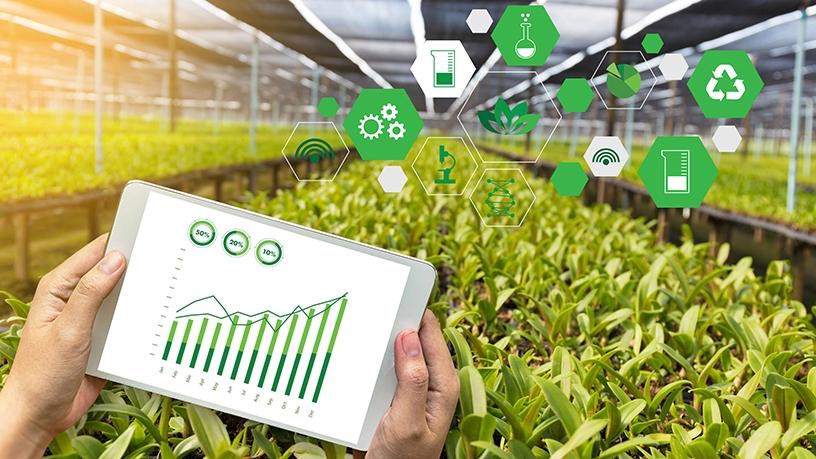
Data is needed for successful farm and production layout. To produce quality products, it is necessary to ensure that a production system is planned, the farm-layout is suitable and that everything possible is done to ensure a quality product.
The following data can assist with the layout and the production planning:

Data is needed by management for planning and to make correct decisions. It is therefore It is It is important that the available information is correct and complete.
Collecting Data
Data collection must be accurate, guesstimates are not scientific collected data be collected at the same intervals be relevant be over a specified period (a year, growth season) use the same units be collected at the right time (daily, weekly etc)
Data can be collected using various methods collect it yourself use instruments e.g. Weather station, tensiometers, Information can be collected from the internet and satellite information Send samples away for analysis observations
Data collection is done with various instruments:
Thermometer – measure temperature on a specific scale; we use Celsius as the scale with 0ºC as freezing point and 100ºC as boiling point, A minimum and maximum thermometer is normally used to indicate the minim and maximum temperature of the day A alcohol wet ball thermometer is used to determine the temperature of a fluid Soil temperature can also be determine
Rain gauge - is available in various forms; the most common one for use is a plastic cone that is erected in an area where there is no obstacles to influence the measurements
Tensiometers – measures water tension in the soil, indicating when to irrigate or not and what the water status in the soil is.
pH and EC meters – this instrument is used to determine the pH – level of acidity of fluids and the electro conductivity of the fluids
Evaporation pan. The evaporation pan is used to determine the daily evaporation rate of water from an open surface. This instrument is used in the scheduling of irrigation.
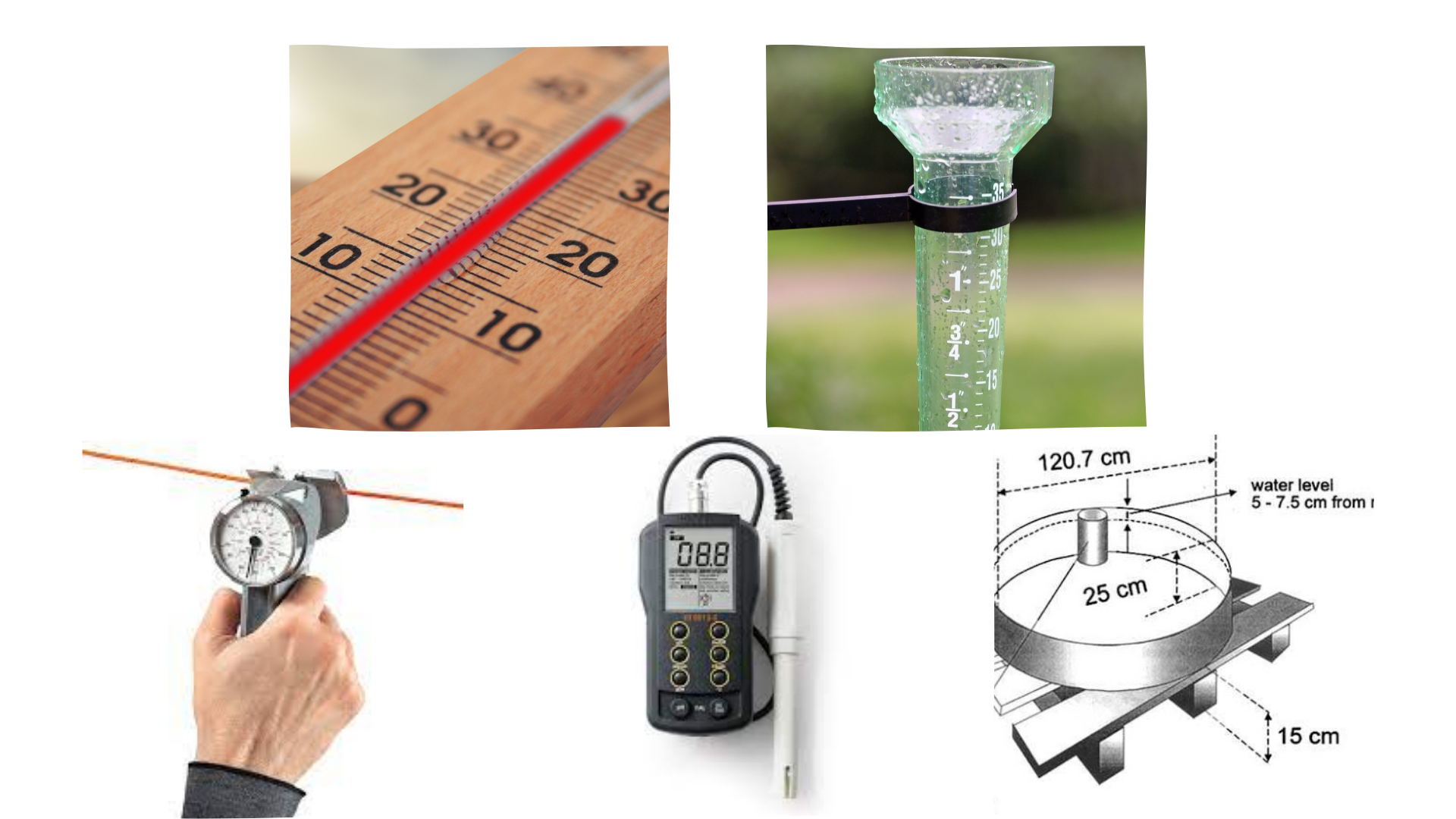
Data collection is the recording of data on a regular basis and at the same interval to determine any changes. This recording must be accurate. In most cases the collection of data involves the writing down of information e.g. temperature and rainfall quantities.
Data collection also involves the taking of samples that need to be analysed or send away for analysis e.g., soil, water or milk samples. The purpose of this is quality control and to find information.
Parts of the plants can also be used to collect data e.g. leave analysis to determine whether the plant received enough nutrients; or fruit analysis to determine whether the product is ready for harvesting. Animal products can be analysed to determine quality, or to determine disease infection, e.g. mastitis test in milk before milking and Somatic cell counts. Blood smears can also be taken to be observed under a microscope or blood samples send away for analysis.
Important Data
|
Infrastructure |
Information needed |
|
Buildings |
Soil type to adjust the foundation to support the building. Movement of the soil for the foundation and to prevent the building from cracking. Daily Temperature – to design the building in such a way to neutralise extreme temperatures or make provision for heating or cooling. Type of building material to be used. Purpose of the building. |
|
Fences |
What is the purpose of the fence – Security, boundary or the fencing off of grazing camps? What must the fence control - Sheep, goats, game or cattle? Soil type - for the supports of corner posts. |
|
Water provision |
Distance to water point. Strength of the water source. Booster pumps or gravity feed? Depth of the bore hole, strength of water supply, distance it needs to be pumped - to determine the pump size. The water needs of the animals or plants. |
|
Irrigation |
Evaporation, precipitation (rainfall), transpiration from the plant, wind speed, heat, readings from tensio-meters and temperature - all this information is needed for scheduling the programme. The required quantity of water needed (per irrigation interval). |
|
Financial information |
Cost of fuel, fertiliser, herbicides and pesticides Application rate – soil fertility Hours worked and fuel consumption Repair and maintenance cost Other inputs Plant population and quantity of seed used Stock holding |
|
Production information |
Plant population and row width to make yield estimation. Calibration of planters and spraying equipment. Products harvested from specific area, land or orchard. |
|
Roads |
Ensure good quality products without bruises. Repair and maintenance cost for vehicles will be lower. The construction of access roads to production areas. To prevent erosion and should be built along the contours. |
|
Category |
Data needed |
|
Weather /climate information |
Wind speed and wind direction. Temperature - minimum and maximum. Rainfall. Evaporation. Sunlight hours. |
|
Soil information |
Soil type Soil structure Organic or humus content Soil fertility Slope of the soil Topography Soil profile |
|
Natural vegetation |
Different types of vegetation Grass coverage, the quality, and the use thereof Trees and scrubs Different biomes |
|
Land |
Land type Area of land Topography |
|
Financial data |
Input costs and consumption Fuel Cultivation Fertiliser Seed Herbicides Pesticides Spraying Harvest Land preparation |
|
Animals |
Feeding cost Housing cost Breeding cost Production cost Carrying capacity Feed conversion ratio (FCR) Average daily gain (ADG) Daily production per animal |
Presenting Data
Data must be presented in an uncomplicated and understandable way to ease management’s decision-making process.
Rainfall information will be captured daily on a monthly or weekly rainfall recording sheet and can be presented in the form of a graph.
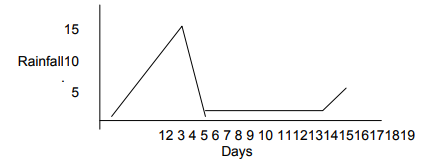
Data collected must be used to make decisions and not only collected for the sake of data collection. Data can be presented in different formats.
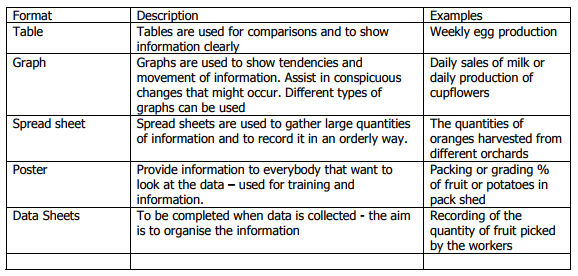
Days harvested:
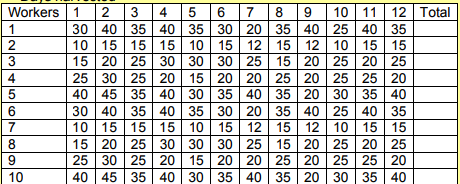
Data can be processed by hand or it can be captured on a computer where it is stored and used to present information. Various new data lodgers are available to assist with the electronic capturing of data to eliminate the human factor. This is an example of the use of data in a Piggery where an AI (Artificial Insemination) program is implemented.
Example: The sow’s inseminated date is recorded in a computer program. The following information will now be available; Next heat date. Possible furrowing date (giving birth). Inoculation Program for this sow. Feeding program. Date when she must be prepared for furrowing.

The manager of the dry sow unit can use this data to observe the sow and prepare her for furrowing; this will ease management and increase productivity and production. The School for Bio Resources Engineering and Environmental Hydrology of the KZN University developed the ACRU model that can be used to determine the effect of water on the soil and crops. www.beeh.unp.ac.za Other computer models are available for e.g. irrigation scheduling.